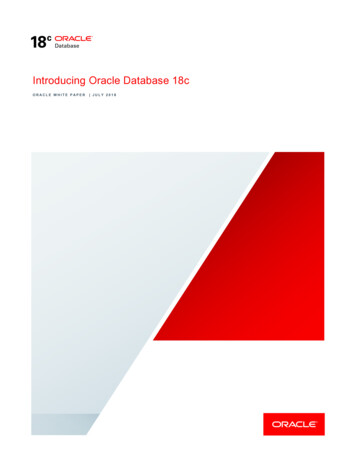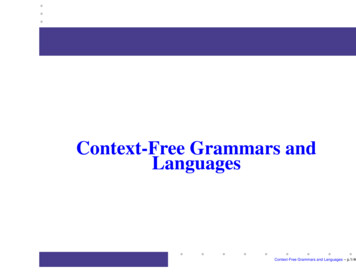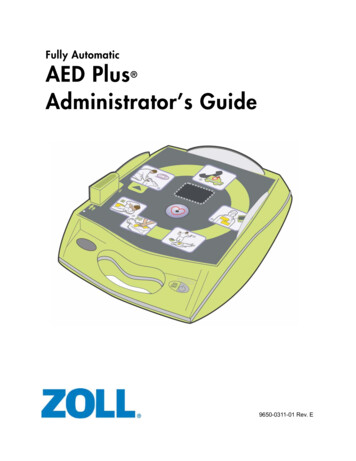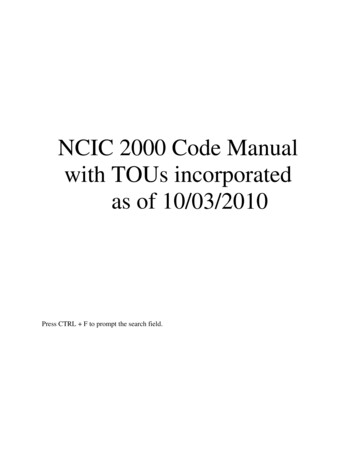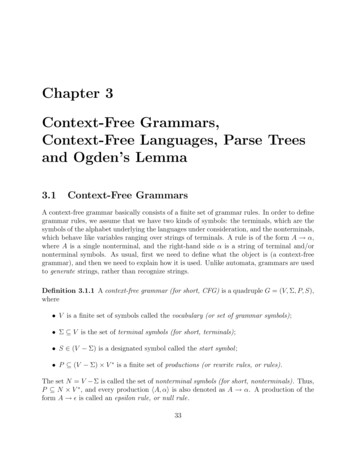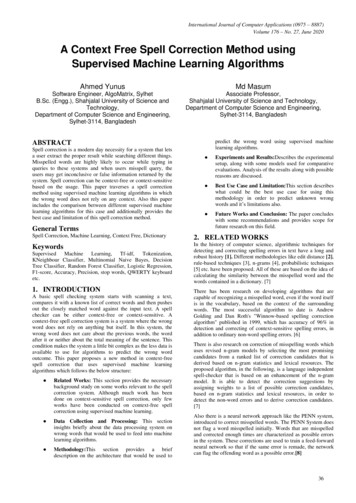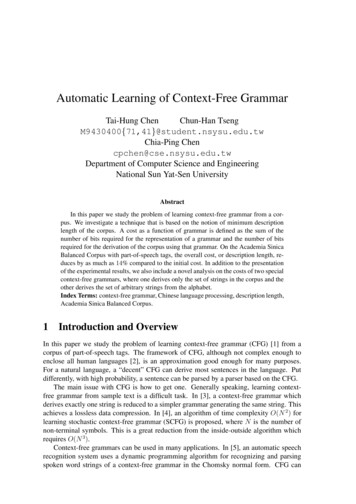
Transcription
Automatic Learning of Context-Free GrammarTai-Hung ChenChun-Han TsengM9430400{71,41}@student.nsysu.edu.twChia-Ping Chencpchen@cse.nsysu.edu.twDepartment of Computer Science and EngineeringNational Sun Yat-Sen UniversityAbstractIn this paper we study the problem of learning context-free grammar from a corpus. We investigate a technique that is based on the notion of minimum descriptionlength of the corpus. A cost as a function of grammar is defined as the sum of thenumber of bits required for the representation of a grammar and the number of bitsrequired for the derivation of the corpus using that grammar. On the Academia SinicaBalanced Corpus with part-of-speech tags, the overall cost, or description length, reduces by as much as 14% compared to the initial cost. In addition to the presentationof the experimental results, we also include a novel analysis on the costs of two specialcontext-free grammars, where one derives only the set of strings in the corpus and theother derives the set of arbitrary strings from the alphabet.Index Terms: context-free grammar, Chinese language processing, description length,Academia Sinica Balanced Corpus.1 Introduction and OverviewIn this paper we study the problem of learning context-free grammar (CFG) [1] from acorpus of part-of-speech tags. The framework of CFG, although not complex enough toenclose all human languages [2], is an approximation good enough for many purposes.For a natural language, a “decent” CFG can derive most sentences in the language. Putdifferently, with high probability, a sentence can be parsed by a parser based on the CFG.The main issue with CFG is how to get one. Generally speaking, learning contextfree grammar from sample text is a difficult task. In [3], a context-free grammar whichderives exactly one string is reduced to a simpler grammar generating the same string. Thisachieves a lossless data compression. In [4], an algorithm of time complexity O(N 2 ) forlearning stochastic context-free grammar (SCFG) is proposed, where N is the number ofnon-terminal symbols. This is a great reduction from the inside-outside algorithm whichrequires O(N 3 ).Context-free grammars can be used in many applications. In [5], an automatic speechrecognition system uses a dynamic programming algorithm for recognizing and parsingspoken word strings of a context-free grammar in the Chomsky normal form. CFG can1
also be used in software engineering. In [6], the components in a source code that needto be renovated are recognized and new code segments are generated from context-freegrammars. In addition, since parsing outputs larger and less-ambiguous meaning-bearingstructures in the sentence, for high-level natural language processing tasks such as questionanswering [7] and interactive voice response [8] systems, the design and implementationof CFG can be crucial to their success.If the goal of learning is to acquire a grammar that derives most sentences in the domainof interest, then a good one is apparently domain-specific. An all-purpose CFG is not likelyto be the best since it tends to derive a much larger set than is necessary. We thus proposeto learn CFGs from corpus. The basic problem is this: Given a set of sentences, we wantto find a set of derivation rules that can derive the original set of sentences. Note thatthere are infinitely many CFGs from which the original set of sentences can be derived. Todiscriminate one CFG from another, we will consider the costs they incur in deriving theoriginal corpus. The cost functions will be defined shortly. Thus, we are proposing to findthe set of rules that can derive the original language with the minimum cost.This paper is organized as follows. Following this introduction and review, we analyzetwo special cases of CFG and the proposed rules in Section 2. The experimental results arepresented in Section 3 followed by discussion and comments. In Section 4, we summarizeour work.2 Mathematical Analysis2.1 The Cost FunctionsThere are two different kinds of costs in the description of a corpus by a CFG. The firstkind is incurred from the representation of the CFG. A rule in a CFG is of the formA β.(1)It consists of a non-terminal symbol A on the left-hand side and a string of symbols β onthe right-hand side. The cost of a rule is the number of bits needed to represent the left-handside and right-hand side. For (1), this isCR (1 β ) log Σ ,(2)where Σ is the symbol set and Σ is the number of symbols in Σ.The second kind is the cost to derive the sentences given the rules. In order to derive asentence W , the sequence of rules must be specified in the derivation from S 1 to W , S α1 · · · W, or S W,(3)where we have adopted the notation defined in [1]. The sequence of rules always startswith one of the S-derivation rules2 ,S α.(4)This step results in a derived string α. If there is no non-terminal symbols in α, we aredone with the derivation. Otherwise, we expand the left-most non-terminal symbol, say X,12S is known as the sentence symbol or the start symbol.The Z-derivation rules are those with Z as the left-hand side.2
in α by one of its derivation bodies3 . The process continues until there is no non-terminalsymbols in the derived string, which will be the sentence W at that point. To illustrate,suppose we are given the CFG R1 (S) : S XXC . . R1 (X) : X AB . .and we want to derive the sentence W ABABC. For this example, one can verifythat the derivation sequence is R1 (S)R1 (X)R1 (X), where Rt (Z) represents the tth Zderivation rule. The cost ism log R(sk ) log R(S) log R(X) log R(X) ,(5)CD k 1where m is the number of rules in the derivation sequence, s k is the non-terminal symbol forthe kth derivation, and R(sk ) is the number of rules in the CFG using sk as the left-handside.Combining (2) and (5), the total cost isC p CR (i) i 1q CD (j) p j 1ni log Σ i 1q mj log R(sk ) ,(6)j 1 k 1where p is the number of rules, q is the number of sentences, ni is the number of symboltokens in rule i, and mj is the length of the derivation sequence for sentence j.2.2 Special-Case AnalysisWe will analyze the costs for two special CFGs in this section. The first CFG, which wecall the exhaustive CFG, uses every distinct sentence in the corpus as a direct derivationbody of the start symbol S. The corpus is thus covered trivially. To compute the cost,we first rearrange the sentences in the lexicographic order and then move the repeatedsentences to the back. The number of symbols for a rule is simply the number of words ofthe corresponding sentence nw , plus 1 (for the start symbol S), and Σ is the vocabularysize V of the corpus plus 1 (again for the start symbol). Thus the rule cost isCR n log Σ (nw 1) log( V 1).(7)In this case, each sentence is derived from S in one step, by specifying the correct one outof the R(S) rules. Thus the derivation cost for a sentence isCD log R(S) .(8)Note that q is generally not equal to R(S) as there may be repeated sentences. Combining(7) and (8), the total cost for the exhaustive CFG is R(S) C i 13CR (i) q j 1 R(S) CD (j) (nw (i) 1) log( V 1) q log R(S) .i 1This is also known as the leftmost derivation.3(9)
The second case, which we call the recursive CFG, uses recursive derivation for S,S AS,(10)where the non-terminal A can be expanded to be any word in the vocabulary. Combinedwith the rule S , this CFG clearly covers any string of the alphabet, Σ , which is amuch larger set than any real corpus.The rule cost is significantly smaller in recursive CFG than that of the exhaustive CFG.The only rules are the two instances of S-derivation and the V instances of A-derivation,so the rule cost is(11)CR n log Σ ,where n can be 1, 2 or 3 depending on the rule. The derivation cost, however, is muchlarger. To derive a sentence W of nw words, the recursive rule of S and substitution ruleof A have to be applied alternatively for nw times, followed by a final rule of S . Thusthe derivation cost for a sentence isCD nw (1 log V ) 1.(12)Combining (11) and (12), the total cost for the recursive CFG is2 V C ni log Σ i 1q CD (j)j 1 (4 2 V ) log( V 2) q (13)[nw (j)(1 log V ) 1].j 1In Table 1 we list the costs of these cases computed on the Academia Sinica BalancedCorpus [9] (ASBC). The exhaustive CFG has a large rule cost (28.1 million bits) and a smallderivation cost (4.1 mb). The recursive CFG has an extremely small rule cost (merely 607bits) and an extremely large derivation cost (88.4 mb). To overall cost is higher for therecursive CFG (88.4 mb) than the exhaustive CFG (32.2 mb). From this table, one cansee that there is a trade-off between the rule cost and the derivation cost. In addition, thenumbers illustrate the important point that minimizing the rule cost alone will lead to aCFG that is inappropriate.The exhaustive CFG is too restricted in the sense that it covers only those sentencesseen in the learning corpus. The recursive CFG is too broad in the sense that it covers allsentences including the non-sense ones. Our goal is to strike a balance between these twoextremes.2.3 Proposed RulesThe special cases we analyze above do not have the minimum cost of all possible CFGsfrom which the corpus can be derived. To reduce the overall cost, we start with the initialCFG and then iteratively look for a new CFG rule. The kind of rules we investigate in thisstudy is of the formX Y Z.The introduction of such a rule to the exhaustive CFG described in Section 2.2 has thefollowing impacts on the cost:4
Each occurrence of Y Z is replaced by X, so the total number of symbol tokens inthe S derivation rules is reduced. Σ is incremented by 1. The derivation cost may or may not change, depending on whether two or more ofthe S-derivation rules become identical.Since there are two symbols on the right-hand side, the number of candidate rules is Σ Σ Σ 2 , where Σ is the current symbol set. To choose one, we compute the bigramcounts of all bigrams and use the bigram with the highest count as the right-hand side ofthe new rule, whose left-hand side is a new symbol.3 Experiments3.1 Data PreparationWe use the ASBC corpus for our experiments. In this corpus, the part-of-speech tag islabeled for each word. On the raw text data, we apply the following pre-processing steps:1. The punctuation of period, question mark and exclamation mark are used to segmenta sentence into multiple sentences.2. The parenthesis tags are discarded.3. The part-of-speech tag sequence is extracted for each sentence.The initial statistics of the data after pre-processing is summarized in Table 2. A total of229852 sentences are extracted and 203651 of them are distinct. The total number of tokensis 4.84 millions. Note that in the experiments, the symbols are the part-of-speech tags ratherthan the words for our CFG learning algorithm. This approach focuses more directly onthe syntax and alleviates the issue of data sparsity.3.2 ResultsThe learning process is an iterative algorithm. We start with the exhaustive CFG introducedin Section 2.2. In each epoch, we1. compute the bigram counts for each bigram,2. make a new rule with the bigram of the largest count as the right-hand side,3. update the alphabet (symbol set), rules and derivations,4. update the costs.The representation cost as a function of the number of learned rules is presented in Figure 1.There are three curves in the plot, representing the rule cost, the derivation cost and thetotal cost. The initial cost is 32.2 million bits, as we show in Section 2.2. As the learningprocess progresses, the two kinds of cost behave in different ways: the derivation cost stays5
constant while the rule cost decreases. The derivation cost is invariant for two reasons: 1)the number of S-derivation rules does not change and 2) there is no ambiguity in expandingnon-S symbols, in our current learning scheme. The rule cost reduces because the decreasein the number of tokens in the rules outweighs the increase in the size of symbol set. As aresult, the total cost reaches a minimum of 27.7 million bits when the 92nd rule is learned.The cost reduction is 14.0%. After the 92nd rule, the largest bigram count is not highenough for the reduction of the number of tokens to outweigh the increase in the alphabet,so the cost increases. The maximum bigram count is plotted against the epoch (number ofrules learned) in Figure 2. From this figure, one can see that the maximum bigram countdecreases very fast.The top-20 rules learned from ASBC are listed in Table 3. In this table, we also include examples of words and sentences from ASBC. In addition, the definition and moreexamples of the part-of-speech tags are listed in Table 4. From Table 3, one can see thatthe new symbols (M1, . . . , M20) here indeed represents larger phrasal structures than thebasic part-of-speech tags. Furthermore, M7 and M9 embed M1, giving evidence for a deepparsing structure. In Figure 3, two sentences in ASBC parsed based on the learned CFG(left) and parsed manually (right) are shown. We can see that the verb phrase (VP) structureof sentence (a) in both parses. For sentence (b), the VP is scattered in two subtrees M 40and M 66. The symbol M 66 can be identified as a noun phrase (NP).4 SummaryThe construction of a context-free grammar for a specific domain is a non-trivial task. Tolearn a CFG automatically from corpus, we define a cost function as the number of bitsfor the representation of CFG and sentence derivation. Our objective is to find a grammarthat covers the learning corpus with the minimum cost. We analyze two extreme cases toillustrate the framework. The proposed rules are learned from heuristic bigram counting.The results show that on ASBC corpus, the reduction of cost is 14.0% of the initial cost.There are other kinds of CFG rules that are not considered in this study, such as theA B C rules. The candidate set of rules should be enlarged for more descriptive power.Another line of research is to extend the current work to the word level (as opposed tothe part-of-speech level). This should be doable at least in a restricted domain. Finally,from the data compression and information theory [10], one can design a different costfunction that takes the symbol frequencies into account and achieves further reduction onthe number of bits.5 AcknowledgementThis work is supported by National Science Council under grant number 94-2213-E-110061. We thank Sheng-Fu Wang and Chiao-Mei Wang for inspirational discussions. Wealso thank the reviewers for the thorough comments.6
Table 1: Costs in bits of exhaustive (G1) and recursive (G2) CFGs.G1G2rule cost derivation cost total cost28.1m4.1m32.2m60788.4m88.4mTable 2: Initial data statistics for ASBC after text pre-processing. V is the vocabularysize, q is the total number of sentences, R(S) is the total number of distinct sentences,Nq is the total number of tokens in the corpus, and NR is the total number of tokens in thedistinct sentences. V q R(S) 51 229852 203651NqNR4838540 4729276Table 3: Top-20 rules learned from the ASBC corpus.X Y ZM1 DE NaM2 Na NaM3 Neu NfM4 Na DM5 D DM6 D VCM7 Na M1M8 Na VCM9 VH M1M10 DE NvM11 VH NaM12 P NaM13 P NcM14 Nh DM15 Nep NfM16 VC NaM17 Nc NaM18 Dfa VHM19 D VHM20 D SHI(Y)(Z)AB -7
Table 4: Selected part-of-speech tags used in the ASBC corpus.NameADDEDfaNaNcNeuNepNfNhNvPSHIVHVCCost ( million bits )35( 92 , 27.711 )30total cost25rule cost20( 92 , 23.658 )1510derivation cost50050100150200250300350400450number of rules learnedFigure 1: The cost as a function of the number of learned rules.8500
Count ( 10000 times )201816141210864( 92 , 0.4776 )20050100150200250300turns of choosing YZsFigure 2: The maximum bigram count as a function of the number of epochs.Figure 3: Examples parsed by the learned CFG (left) and parsed manually (right). HereCbb is conjunctive and VJ is transitive verb.9
References[1] J. E. Hopcroft, R. Motwani and J. D. Ullman, “Introduction to Automata Theory,Languages and Computation”, Addison-Wesley (2001).[2] D. Jurafsky and J. H. Martin, “Speech and Language Processing: An Introduction toNatural Language Processing, Computational Linguistics, and Speech Recognition”,Prentice Hall (2000).[3] John C. Kieffer and En-hui Yang, “Design of context-free grammars for lossless datacompression,” Proceedings of the 1998 IEEE Information Theory Workshop, pp. 8485.[4] H. Lucke, “Reducing the computation complexity for inferring stochastic context-freegrammar rules from example text”, Proceedings of ICASSP 1994, pp. 353-356.[5] H. Ney, “Dynamic Programming Speech Recognition Using a Context-Free Grammar”, Proceedings of ICASSP’87, pp. 69-72.[6] Mark van den Brand, Alex Sellink, and Chris Verhoef, “Generation of components forsoftware renovation factories from context-free grammars”, In Working Conferenceon Reverse Engineering, IEEE Computer Society, WCRE97, pp. 144-153.[7] C. Yuan and C. Wang, “Parsing model for answer extraction in Chinese questionanswering system”, Proceedings of IEEE NLP-KE ’05, pp. 238 - 243.[8] M. Balakrishna, D. Moldovan, E.K. Cave, “Automatic creation and tuning of contextfree grammars for interactive voice response systems”, Proceedings of IEEE NLP-KE’05, pp. 158 - 163.[9], ] T. Cover and J. Thomas, “Elements of Information Theory”, John Wiley and Sons(1991).10
free grammar from sample text is a difficult task. In [3], a context-free grammar which derives exactlyone stringis reducedtoasimpler grammar generatingthe same string. This achieves a lossless data compression. In [4], an algorithm of time complexity O(N2) for learning stochastic context-free grammar (SCFG) is proposed, where N is the number of
